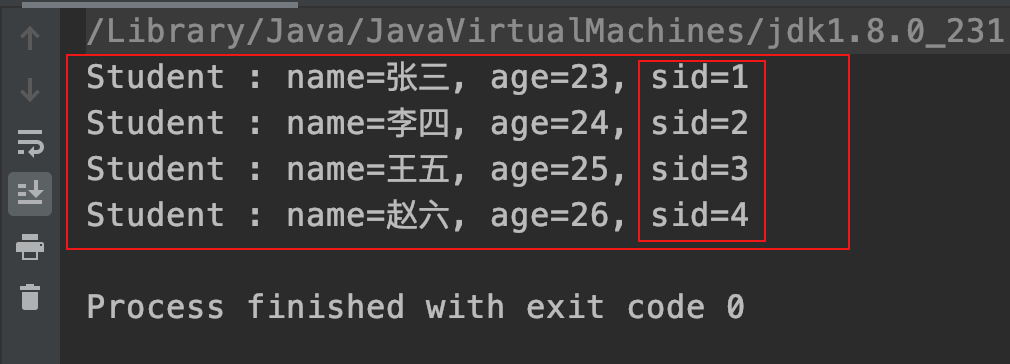静态与唯一(static/final)
阅读 (983778)
分享
1、static
1.1、static概述
static表示静态的意思,可以修饰变量、方法,还可以编写静态代码块。能够直接被类引用。
在我们平时的使用当中,static最常用的功能就是修饰类的属性和方法,让他们成为类的成员属性和方法,我们通常将用static修饰的成员称为类成员(类变量与类方法)或者静态成员(静态变量与静态方法)。
1.2、static应用
1.2.1、类变量
类变量就是用static修饰的成员变量。
class Student {
private String name;
private int age; // 学生的id
private int sid; // 类变量,记录学生数量,分配学号
public static int numberOfStudent = 0;
public Student(String name, int age){
this.name = name;
this.age = age; // 通过 numberOfStudent 给学生分配学号
this.sid = ++numberOfStudent;
}
// 打印属性值
public void show() {
System.out.println("Student : name=" + name + ", age=" + age + ", sid=" + sid );
}
}
public class StaticDemo01 {
public static void main(String[] args) {
Student s1 = new Student("张三", 23);
Student s2 = new Student("李四", 24);
Student s3 = new Student("王五", 25);
Student s4 = new Student("赵六", 26);
s1.show();// Student : name=张三, age=23, sid=1
s2.show(); // Student : name=李四, age=24, sid=2
s3.show(); // Student : name=王五, age=25, sid=3
s4.show(); // Student : name=赵六, age=26, sid=4
}
}
运行结果:

1.2.2、类方法
static的另一个作用,就是修饰成员方法。相比于修饰成员属性,修饰成员方法对于数据的存储上面并没有多大的变化,因为我们从上面可以看出,方法本来就是存放在类的定义当中的。static修饰成员方法最大的作用,就是可以使用"类名.方法名"的方式操作方法,避免了先要new出对象的繁琐和资源消耗,我们可能会经常在帮助类中看到它的使用:
public class StaticDemo02 {
public static void print(Object o){
System.out.println(o);
}
public static void main(String[] args) {
StaticDemo02.print("Hello world");
}
}
运行结果:

1.2.3、静态代码块
定义在类的里面方法的外面,随着类的加载而执行且执行一次,优先与main()和构造方法执行。
格式:
class A{
static{
}
public void v(){}
}
public class StaticDemo03 {
static int x;
static {
System.out.println("静态代码块");
x = 12;
}
public StaticDemo03(){
System.out.println("构造函数");
}
public static void main(String[] args) {
new StaticDemo03().print();
}
public void print(){
System.out.println(x);
}
}
运行结果:

2、final
2.1、final概述
在java中,final的含义在不同的场景下有细微的差别,但总体上来说,它指的是“这是不可变的”。
2.2、final应用
2.2.1、修饰类
都是被final修饰的类,目的就是供我们使用,而不让我们所以改变其内容。
final class T{//T为一个功能类,Scanner\Random
public void t(){
System.out.println("T");
}
}
public class FinalDemo01 extends T {//不能被继承
public static void main(String[] args) {
}
}
2.2.2、修饰方法
final修饰的方法,不能被重写
class T {
public final void t() {//final修饰的方法是唯一的
System.out.println("T");
}
}
public class FinalDemo01 extends T {
public void t() {//不能被重写
System.out.println("FinalDemo01");
}
public static void main(String[] args) {
}
}
2.2.3、修饰变量
成员变量
被final修饰的成员变量是一个常量,叫符号常量。一般都有书写规范,所有字母都大写。
class A{
final double PI=3.1415926;
}
局部变量
声明的变量是唯一的不能重新赋值。
public class FinalDemo02 {
public static void main(String[] args) {
// 声明变量,使用final修饰
final int a;
// 第一次赋值
a = 10;
// 第二次赋值
a = 20; // 报错,不可重新赋值
// 声明变量,直接赋值,使用final修饰
final int b = 10;
// 第二次赋值
b = 20;
// 报错,不可重新赋值
}
}
需要
登录
才可以提问哦
:

